Trigonometry
Trigonometry takes on two distinct forms:
Each one plays a huge role in basic physics, calculus and engineering
right triangle trig: force diagrams, geometry, vector analysis
oscillating functions: calculus, mass-spring systems, circuits, sound,
and any vibrations
Contents:
1. Right Triangle Trig
1.1 Pythagorean Theorem
1.2 SOH CAH TOA and similar triangles
1.3 Trig values for 0°, 30°,45°,60°, and 90°
1.4 Degrees and Radians
1.5 Trig Identities
2. Oscillating Functions
2.1 basics of sine and cosine
2.2 period
2.3 frequency
2.4 phase shift
2.5 standing waves
1. Right Triangle Trigonometry
The Pythagorean Theorem is the cornerstone of trigonometry and analytic geometry. It relates the lengths of the sides of right triangles. First you need to remember the terminology:

If we denote the lengths of the three sides by a and b for the legs and c for the hypotenuse, then in a flat plane the Pythagorean Theorem states that
c2 = a2 + b2
The most widely known right triangle is perhaps the “3-4-5” triangle shown below
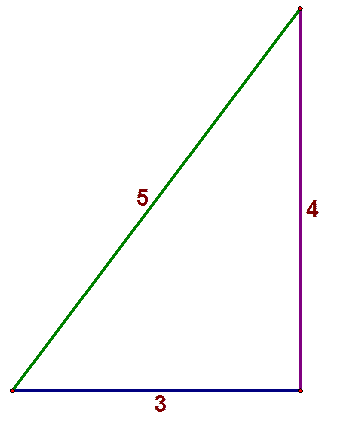
where we note that 32 + 42 = 9 + 16 = 25 = 52. Other right triangles with integer sides are 5-12-13 and 20-21-29. The reader should check that the two sets of numbers really do satisfy the Pythagorean Theorem.
Skill: Completing the Triangle
One thing that one should be able to do is as follows: given two sides of a right triangle, be able to fill in the length of the third side. This is called “completing the triangle”.
Example 1: Complete the following triangle
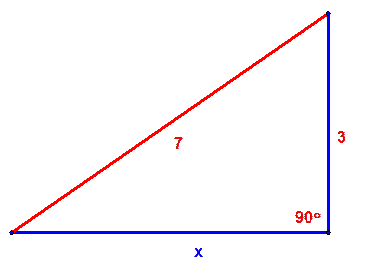
Solution: we must have x2 + 32 = 72
or x2 + 9 = 49
or x2 = 49 – 9 = 40
so x = ![]()
(most problems result in a square root appearing somewhere…)
Example 2: Complete the following triangle
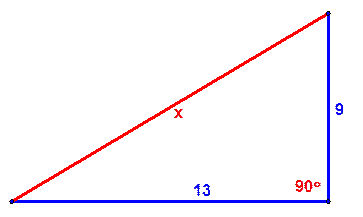
Solution: We need to determine the hypotenuse this time. We have
92 + 132 = x2
or 81 + 169 = x2
or 250 = x2
so x = ![]()
Problem: why is it true that a + b > c ??
1.2 SOH CAH TOA
If one of the angles (not the 90 degree one) are denoted by θ and we distinguish the legs as to being adjacent to the angle or opposite it then the triangle looks like
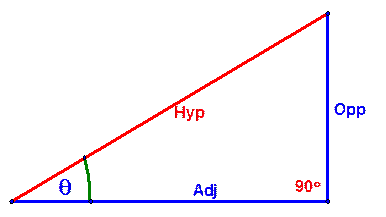
The Pythagorean Theorem in this case states
Hyp2 = Adj2 + Opp2
The basic trig functions are defined as ratios of the sides of the triangle as the legs relate to θ (either adjacent to it or opposite it).
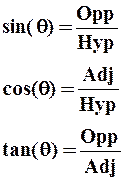
You need to memorize these!!! They are pronounced:
sin(θ) = “sine theta”
cos(θ) = “cosine theta”
tan(θ) = “tangent theta”
For the right triangle shown below, we would then have
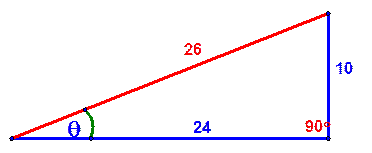
that sin(θ) = 10/26 = 5/13,
cos(θ) = 24/26 = 12/13
and tan(θ) = 10/24 = 5/12.
Sometimes you have to complete the triangle first before you can figure out the values of the trig functions as shown by the following example
Example For the triangle shown below, determine sin(θ), cos(θ) and tan(θ).
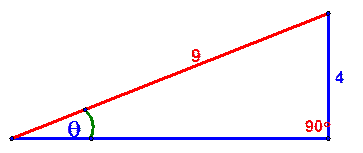
Solution: step 1 – complete the triangle
the adjacent side is found by solving x2 + 42 = 92 or x2 = 81 – 16 =65 so
x = ![]()
step 2 – read off the trig values
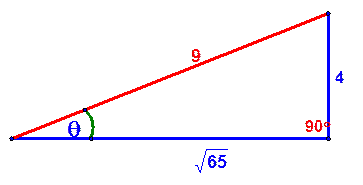
so that
that sin(θ) = 4/9
cos(θ) = ![]() /9
/9
and tan(θ) = 4/![]()
Complementary Angles
It is well known that for any triangle, the sum of all three angles is always 180°.
Now for a right triangle, one of those angles is 90°, so the other two angles add up to 90°. They are called complementary because of this. Thus if you have a right triangle and you know one angle, you really know all three. If, for example, one angle is 37 degrees than the other must be 63 degrees and the triangle might look like
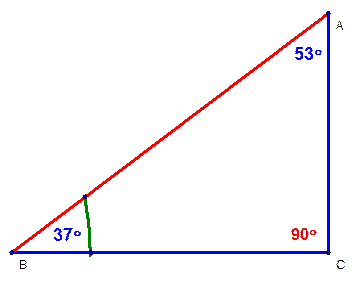
Knowing this and SOH CAH TOA can save us some work. We start with the following triangle and base what follows on it:
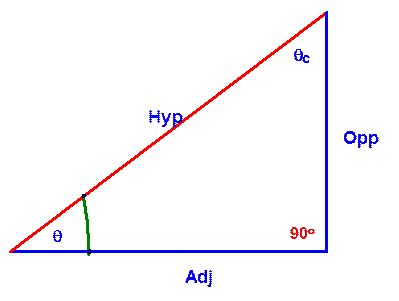
Now, remembering SOH CAH TOA, we can write down all of the following:
sin(θ) = Opp/Hyp
cos(θ) = Adj/ Hyp
as well as (check this)
sin(θc) = Adj/Hyp
cos(θc) = Opp/Hyp
because of where θc is located on the triangle. Putting this together,
cos(θc) = sin(θ) and sin(θc) = cos(θ)
or, equivalently
sin(θ) = cos(90° - θ)
or, put verbally: if you know sine of an angle then you know cosine of its complement, and if you know cosine of an angle, you know sine of its complement.
For example, if we are given that sin(40°) = .643 then we automatically know that cos(60°) = .643 .
If we know that cos(55°) = .82 then we know from this that sin(35°) = .82.
Part of geometry and, in particular trigonometry, is getting all the possible mileage you can out of the given information in a problem…. deductive reasoning.
1.3 Trig values for 0°, 30°,45°,60°, and 90°
You will frequently need to know the values of sine, cosine and tangent for the angles listed above. What follows will try to cut down on the amount of memorization and also explain where the values come from. For starters, we will focus only on sine and cosine and then fall back on the fact that tan(θ) = sin(θ)/ cos(θ).
Our goal is to fill in the following table based on what we know:
θ |
sin(θ) |
cos(θ) |
0° |
|
|
30° |
|
|
45° |
|
|
60° |
|
|
90° |
|
|
45° is a good place to begin. The triangle may look like
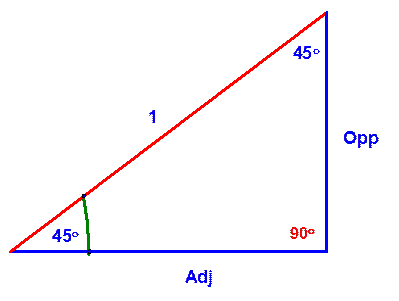
if we make the hypotenuse 1. Note the second 45° because they have to add up to 90°. This makes the triangle isosceles and hence Opp = Adj . By the Pythagorean Theorem, we then have
12 = Adj2 + Opp2 = Adj2 + Adj2 = 2Adj2
so Adj2 = ½ and therefore Adj = ![]()
Therefore the triangle looks like 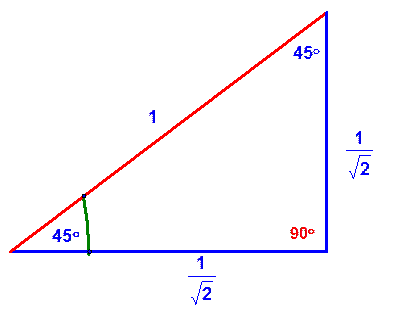
and thus cos(45°)= sin(45°)= ![]() .
.
The table now looks like
θ |
sin(θ) |
cos(θ) |
0° |
|
|
30° |
|
|
45° |
|
|
60° |
|
|
90° |
|
|
Let’s set up an equilateral *triangle with sides 1 unit long:
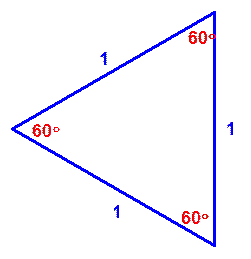
*equilateral means that all three sides are the same length. Isosceles means two equal sides
Now, you point out, this is not a right triangle and we were doing trigonometry, the study of right triangles. True… but let’s add a line from the left vertex to the midpoint of the vertical side. Now things look like
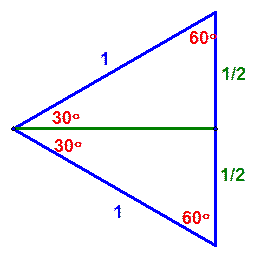
and we note that the green, horizontal line is perpendicular to the vertical, blue line. We have created two, congruent, right triangles, called “30-60-90” triangles. We have 2 of the three sides of each. If we let x denote the length of the green, horizontal side then one of them looks like
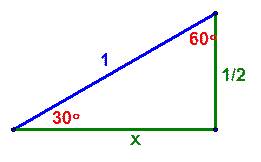
where, from the Pythagorean Theorem, we have x2 + (1/2)2 = 12 so x = ![]()
and the triangle, completed, is
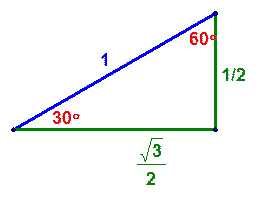
From SOH CAH TOA, we get sin(30°)=![]() = cos(60°) and cos(30°) =
= cos(60°) and cos(30°) = ![]() = sin(60°)
= sin(60°)
The table now looks like
θ |
sin(θ) |
cos(θ) |
0° |
|
|
30° |
|
|
45° |
|
|
60° |
|
|
90° |
|
|
and we note that because of the property of complementary angles discussed earlier, every time we determine 2 trig values, we effectively get 2 more free of charge. Thus if we can figure out sin and cosine of 0° we are really done.
For 0° we can start with a very, very slim triangle with hypotenuse of 1. This might appear as

Remembering that sine is opposite divided by 1 and cosine is adjacent divided by 1, we then imagine θ getting smaller and smaller and becoming 0. The adjacent and the hypotenuse both become the same thing so cos(0°) = 1.
By similar thinking, the opposite side becomes 0 as the angle collapses, so sin(0°) = 0.
The table now looks like
θ |
sin(θ) |
cos(θ) |
0° |
0 |
1 |
30° |
|
|
45° |
|
|
60° |
|
|
90° |
|
|
For 90 degrees the role of sine and cosine are reversed so we can fill in the last row as
θ |
sin(θ) |
cos(θ) |
0° |
0 |
1 |
30° |
|
|
45° |
|
|
60° |
|
|
90° |
1 |
0 |
The property of complementary angles has saved us half the work. It can save you half of the memorization by the following pattern of duplication of values (indicated by corresponding colors):
θ |
sin(θ) |
cos(θ) |
0° |
0 |
1 |
30° |
|
|
45° |
|
|
60° |
|
|
90° |
1 |
0 |
where each pairing occurs for the simple reason that sin(θ) = cos(90° - θ)
Completing Right Triangles Using Trig Functions
This is a skill where, given only the hypotenuse and an angle in a right triangle, one can fill in all three sides of the triangle.
For example, consider the following problem:
Problem: determine all three sides of the triangle shown:
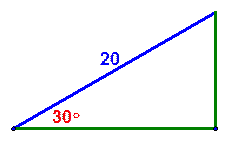
Solution:
Let’s find the adjacent (horizontal) side first. Call it’s value x. Then by definition, the ratio of adjacent to hypotenuse is the cosine of 30 degrees, or
cos(30°) = x/20
= ![]()
so x = 20![]() = 10√3
= 10√3
To next find the opposite (vertical) side, we have two ways to do it: use the Pythagorean Theorem or use trig functions as we just did. We’ll go with the latter to illustrate it as you already know how to use the Pythagorean Theorem
Call this unknown side y. Then by definition
sin(30°) = y/20
= 1/2
so y = 20(1/2) = 10
The triangle, now completed, looks like
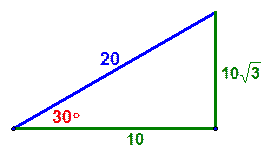
Another approach: we developed the trig values for 30 degrees using a triangle with a hypotenuse of 1 unit and adjacent angle of 30. What we needed in this problem was a triangle 20 times as big and similar (in the mathematical sense) to the original so we just multiply or scale all three sides by 20 and we are done
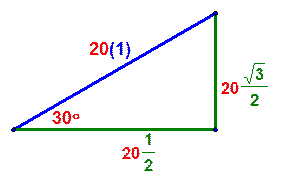
Comment: to do these kinds of problems , you need to know SOH CAH TOA cold as well as the values from the trig table. There is no way around this.
Problem: complete the following triangle
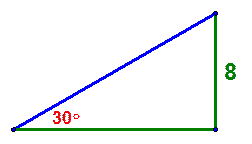
Solution:
let’s get the hypotenuse first. Call it H. By definition
sin(30) = 8/H
We know sin(30) = ½ so ½ = 8/H or H = 8/(1/2) = 16
To get the horizontal side, which we call A, we know that
cos(30) = A/H = A/16
and, from the table, that cos(30) = ![]() so
so
A/16 = ![]()
and A = 16![]() = 8
= 8 ![]()
The completed triangle now looks like
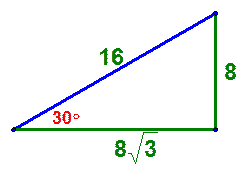
Comment: we can check our work by seeing if our three sides satisfy the Pythagorean Theorem. If not, we made a mistake. In this problem,
![]()
so we are ok.
Problem: complete the following triangle
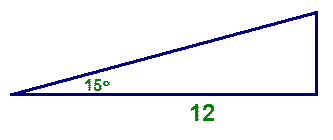
Solution:
let’s call the vertical side y and the hypotenuse h. Then we are looking for values to complete
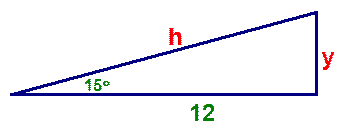
Let’s find h first. By definition, cos(15°) = 12/h so h = 12/cos(15). To finish, we need the cosine of 15 degrees which requires a calculator. This tells us cos(15°) is about .966 so
h = 12/.966 = 12.42
We now have two out of three sides. We can get y either with the Pythagorean Theorem or Trig functions. We will show both
Pythagorean Theorem:
h2 = y2 + 122
(12.423)2 = y2 + 144
10.34 = y2
3.22 = y
Trig functions:
sin(15°) = y/h = y/12.42
but sin(15°) = .259
so y = 12.42 * .259 = 3.21
The “completed” triangle now looks like
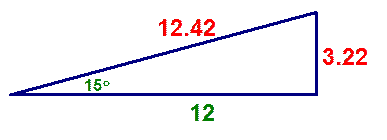
Since decimals were used, roundoff is always going on, so the answers are only 2 decimal place approximations. Your calculator probably allows as much as 8 places.
Depending on the books you use or courses you take, angles may be specified in either degrees or radians. You need to be competent in both. This is easy.
First we assume you are familiar with degrees and know there are 360 degrees in a complete circle.
Secondly we point out that there are also 2π radians in a circle, or about 6.28 radians because π is approximately 3.14
Thus we have the critical conversion formula
360° = 2π radians
or
180° = π radians
This last formula is really all you need to remember!! Just multiply or divide accordingly and you can make any conversion.
For example:
60° = π/3 radians (just divide by 3)
90° = π/2 radians
150° = (5/6) π radians
with this kind of simple algebra, we can rebuild our trig table from earlier:
θ (deg) |
θ (rad) |
sin(θ) |
cos(θ) |
0° |
0 |
0 |
1 |
30° |
π/6 |
|
|
45° |
π/4 |
|
|
60° |
π/3 |
|
|
90° |
π/2 |
1 |
0 |
and comment that you really should memorize both ways, degrees and radians.
Problem : What about the other direction?
What does 2 radians convert to in degrees? We have from above that
180° = π radians
Dividing both sides by π we have what 1 radian is
180°/ π = 1 radian
Multiplying both sides by 2 gives us
360/ π° = 2 radians
Now if you get out your calculator and divide 360 by 3.14 you find we have
114.59° = 2 radians
to finish the problem. Note we carried the units all the way along for clarity.
Now while we are at it, we can divide by 2 and find the useful fact that
57.29° = 1 radian
The Pythagorean Theorem says that, for our original right triangle,
Hyp2 = Adj2 + Opp2
Dividing both sides by Hyp2 we then easily have

and if we remember SOH CAH TOA, this is the same as
1 = sin2(θ) + cos2(θ) (trig identity #1)
this is a very useful identity and should be memorized. It is really nothing more than the Pythagorean Theorem applied to sine and cosine.
From SOH CAH TOA we have that
tan(θ = Opp/Adj
but sin(θ) = Opp/Hyp and cos(θ)= Adj/Hyp so

so tan(θ) = sin(θ)/cos(θ)) (trig identity #2 )
If we divide both sides of trig identity #1 by cos2(θ) then we have

or, since 1/cos is defined as secant,
sec2(θ) = tan2(θ) + 1 (trig identity #3)
This identity appears often in calculus courses.
Other identities:
sin(2θ) = 2 sin(θ) sin(θ)
sin2(θ) = ![]()
cos2(θ) = ![]()
which are used in Calculus II and Differential Equations, among other places.
2. Oscillating Functions
The other use of trig functions is for oscillations. These occur in vibrations in physics and mechanical engineering as well as electrical circuits.
2.1 Basics of Sine and Cosine
For starters we begin with a circle of radius one and a radius from the origin to a point (x,y) on it.
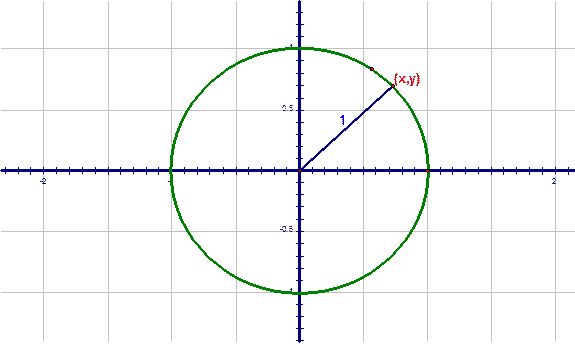
Now if we drop a perpendicular to the x axis then we have a familiar looking right triangle:
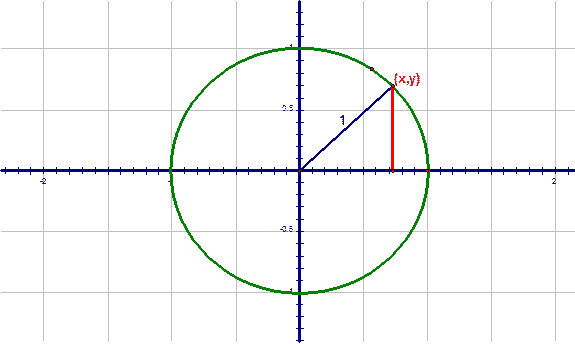
and if θ is the angle between the x-axis and the radius then the horizontal and vertical sides, respectively, have lengths of cos(θ) and sin(θ). Remembering how Cartesian coordinates are plotted, this means that
x = cos(θ) and y=sin(θ)
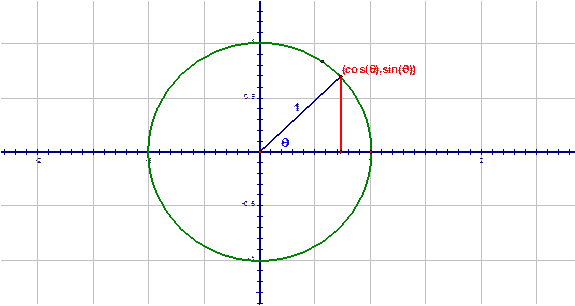
Now at this point, this is nothing more than we did earlier, just superimposed on the x-y coordinate system. We even have a table of the coordinates of x and y for 5 different values of θ.
What becomes new is when θ exceeds 90° and we move in to the other quadrants instead of remaining in the first quadrant.
We need to take a second and review the signs (+, -) of points in other quadrants:
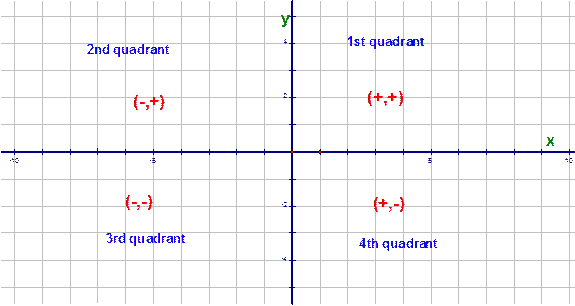
If, for θ > 90°, we define x as cos(θ) and y as sin(θ) then the functions take on both positive and negative values.
The graphs of cosine and sine, plotted versus the angle θ, look like:
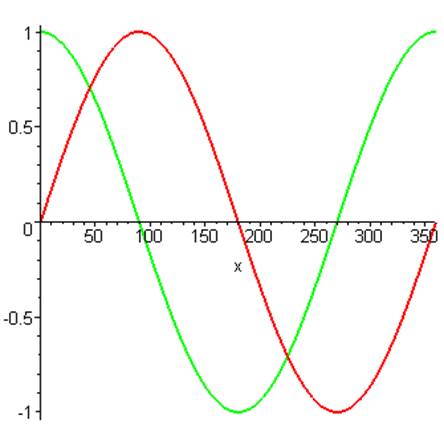
where cosine is in green and sine is in red. The reader should compare the values on the graphs above, for the first 90 degrees, with those obtained earlier and put into the table
θ |
sin(θ) |
cos(θ) |
0° |
0 |
1 |
30° |
|
|
45° |
|
|
60° |
|
|
90° |
1 |
0 |
The only trouble with this is that the values in the table are in fraction form. If they are converted to decimals then it might be easier to relate to the graph. This is done below:
θ |
sin(θ) |
cos(θ) |
0° |
0.00 |
1.00 |
30° |
.500 |
.866 |
45° |
.707 |
.707 |
60° |
.866 |
.500 |
90° |
1.00 |
0.00 |
Source: http://users.wpi.edu/~goulet/BasicMath/Trigonometry_text.doc
Web site to visit: http://users.wpi.edu
Author of the text: not indicated on the source document of the above text
If you are the author of the text above and you not agree to share your knowledge for teaching, research, scholarship (for fair use as indicated in the United States copyrigh low) please send us an e-mail and we will remove your text quickly. Fair use is a limitation and exception to the exclusive right granted by copyright law to the author of a creative work. In United States copyright law, fair use is a doctrine that permits limited use of copyrighted material without acquiring permission from the rights holders. Examples of fair use include commentary, search engines, criticism, news reporting, research, teaching, library archiving and scholarship. It provides for the legal, unlicensed citation or incorporation of copyrighted material in another author's work under a four-factor balancing test. (source: http://en.wikipedia.org/wiki/Fair_use)
The information of medicine and health contained in the site are of a general nature and purpose which is purely informative and for this reason may not replace in any case, the council of a doctor or a qualified entity legally to the profession.
The following texts are the property of their respective authors and we thank them for giving us the opportunity to share for free to students, teachers and users of the Web their texts will used only for illustrative educational and scientific purposes only.
All the information in our site are given for nonprofit educational purposes
The information of medicine and health contained in the site are of a general nature and purpose which is purely informative and for this reason may not replace in any case, the council of a doctor or a qualified entity legally to the profession.
www.riassuntini.com